Green Small Cell Operation of Ultra-Dense Networks Using Device Assistance †
Abstract
:1. Introduction
2. System Model
2.1. Assumptions
2.2. Problem Formulation
3. Belief Propagation
3.1. Factor Graph
3.2. Belief Propagation Optimization Algorithm
- Initialization. At time , messages for and are set to have an arbitrary distribution. For instance, we use the uniform distribution, such as:
- UE update. After the initialization, UE generates and sends the belief messages to its neighboring APs where denotes the neighbor APs of UE i. At , the message update is defined by:Therefore, when the expectation (11) is calculated over independent , , the message update can be presented bywhere for given . Furthermore, in (12) is calculated for given . Since (12) has both a sum and a product, BP is called the sum-product algorithm. Equation (12) is the product of the factor with belief messages from AP , , to UE i, marginalized over all random variables, except . To calculate , at , we assume that , . At , , , is initialized to one and incremented by the number of associated UEs where each UE is associated with AP .
- AP update. AP generates and sends the belief messages to all neighboring UE , where denotes the neighbor UEs of AP j. The message is defined by:where is the normalizing constant making . The belief message (13) is the product of the belief messages from UE , all neighboring factor nodes, except i. Then, the steps ‘UE update’ and ‘AP update’ are repeated until the number of iteration is satisfied.
- Decision-making. After finishing the iteration procedure, the estimated marginal probability distribution with respect to is finalized as:where is the normalizing constant to make as a probabilistic distribution.Then, as a final step, to describe our association rule S, we define an integer-valued function that determines the position of the j-th element when the elements of the input vector are sorted in increasing order. Then, we deliberately use the following rank-based association rule of UE i given by:where , , and η is a weighting parameter considering the tradeoff between the channel condition and the estimated marginal probability from BP. The intuition of (15) is as follows. If each UE is associated with AP j solely considering energy efficiency, then most UEs are associated with a few APs having a higher value of . High may indicate that there is a global consensus that energy efficiency can be increased when the BS j is turned on. However, connecting too many UEs to one AP can degrade the data rate, which may decrease energy efficiency. In this sense, user association cannot be determined solely relying on . Thus, we exploit to determine the user association, so each UE can decide its association along with the global perspective of and also personal perspective to preserve its service quality.Our user association rule can be seen as an extension of the convention user association rule that is based on SINR. For example, if , each UE is associated with the AP that provides the highest SINR among APs in , which is the conventional user association rule. On the other hand, if , the UE is associated with the AP j whose is the greatest. It could be possible that SCC determines η to maximize energy efficiency by using adaptive learning methods. After user association is done for all UEs, the APs with no UEs are turned off.
4. Online Algorithm: DANCE
4.1. Feedback from UE
4.2. DANCE Algorithms
| Algorithm 1 AP-first |
|
| Algorithm 2 UE-first |
|
4.3. Practical Implementation
5. Numerical Results
5.1. BP and DANCE Algorithms for a Small-Sized Network
5.2. Expanding BP and DANCE Algorithms on UDN
5.2.1. Dense Network
5.2.2. Ultra-Dense Network
6. Conclusions
Acknowledgments
Author Contributions
Conflicts of Interest
Abbreviations
| AP | access point |
| UE | user equipment |
| BP | belief propagation |
| BS | base station |
| MNO | mobile network operator |
| EE | energy efficiency |
| SE | spectral efficiency |
| DANCE | Device Assisted Networking for Cellular grEening |
| SCC | small cell controller |
| CN | core network |
| QoS | quality of service |
| SINR | signal-to-interference ratio |
| UDN | ultra dense network |
| AMC | adaptive modulation and coding |
References
- Hwang, I.; Song, B.; Soliman, S.S. A holistic view on hyper-dense heterogeneous and small cell networks. IEEE Commun. Mag. 2013, 51, 20–27. [Google Scholar] [CrossRef]
- Ashraf, I.; Boccardi, F.; Ho, L. Sleep mode techniques for small cell deployments. IEEE Commun. Mag. 2011, 49, 72–79. [Google Scholar] [CrossRef]
- Fettweis, G.; Zimmermann, E. ICT Energy Consumption-Trends and Challenges. In Proceedings of the 11th International Symposium on Wireless Personal Multimedia Communications, Lapland, Finland, 8–11 September 2008; Volume 2, p. 6.
- Oh, E.; Krishnamachari, B.; Liu, X.; Niu, Z. Toward dynamic energy-efficient operation of cellular network infrastructure. IEEE Commun. Mag. 2011, 49, 56–61. [Google Scholar] [CrossRef]
- Hasan, Z.; Boostanimehr, H.; Bhargava, V.K. Green cellular networks: A survey, some research issues and challenges. IEEE Commun. Surv. Tutor. 2011, 13, 524–540. [Google Scholar] [CrossRef]
- I, C.L.; Rowell, C.; Han, S.; Xu, Z.; Li, G.; Pan, Z. Toward Green and Soft: A 5G Perspective. IEEE Commun. Mag. 2014, 52, 66–73. [Google Scholar] [CrossRef]
- Chang, C.Y.; Liao, W.; Hsieh, H.Y.; Shiu, D.S. On Optimal Cell Activation for Coverage Preservation in Green Cellular Networks. IEEE Trans. Mob. Comput. 2014, 13, 2580–2591. [Google Scholar] [CrossRef]
- Niu, Z.; Wu, Y.; Gong, J.; Yang, Z. Cell zooming for cost-efficient green cellular networks. IEEE Commun. Mag. 2010, 48, 74–79. [Google Scholar] [CrossRef]
- Son, K.; Kim, H.; Yi, Y.; Krishnamachari, B. Base Station Operation and User Association Mechanisms for Energy-Delay Tradeoffs in Green Cellular Networks. IEEE J. Sel. Areas Commun. 2010, 29, 1525–1536. [Google Scholar] [CrossRef]
- Lee, G.; Kim, H.; Kim, Y.T.; Kim, B.H. Delaunay Triangulation Based Green Base Station Operation for Self Organizing Network. In Proceedings of the IEEE Green Computing and Communications (GreenCom), Beijing, China, 20–23 August 2013; pp. 1–6.
- Moon, S.; Kim, H.; Yi, Y. BRUTE: Energy-efficient user association in cellular networks from Population Game Perspective. IEEE Trans. Wirel. Commun. 2015, 15, 663–675. [Google Scholar] [CrossRef]
- Soh, Y.S.; Quek, T.Q.; Kountouris, M.; Shin, H. Energy efficient heterogeneous cellular networks. IEEE J. Sel. Areas Commun. 2013, 31, 840–850. [Google Scholar] [CrossRef]
- Cho, S.R.; Choi, W. Energy-efficient repulsive cell activation for heterogeneous cellular networks. IEEE J. Sel. Areas Commun. 2013, 31, 870–882. [Google Scholar] [CrossRef]
- Peng, J.; Hong, P.; Xue, K. Energy-Aware Cellular Deployment Strategy under Coverage Performance Constraints. IEEE Trans. Wirel. Commun. 2014, 14, 69–80. [Google Scholar] [CrossRef]
- Wang, Z.; Zhang, W. A Separation Architecture for Achieving Energy-Efficient Cellular Networking. IEEE Trans. Wirel. Commun. 2014, 13, 3113–3123. [Google Scholar] [CrossRef]
- Cao, P.; Liu, W.; Thompson, J.S.; Yang, C.; Jorswieck, E.A. Semidynamic Green Resource Management in Downlink Heterogeneous Networks by Group Sparse Power Control. IEEE J. Sel. Areas Commun. 2016, 34, 1250–1266. [Google Scholar] [CrossRef]
- Wu, J.; Zhang, Y.; Zukerman, M.; Yung, E.K.N. Energy-Efficient Base-Stations Sleep-Mode Techniques in Green Cellular Networks: A Survey. IEEE Commun. Surv. Tutor. 2015, 17, 803–826. [Google Scholar] [CrossRef]
- Lee, G.; Kim, H. Green Small Cell Operation Using Belief Propagation in Wireless Networks. In Proceedings of the IEEE Globecom Workshops, Austin, TX, USA, 8–12 December 2014; pp. 1266–1271.
- Nakamura, T.; Nagata, S.; Benjebbour, A.; Kishiyama, Y.; Hai, T.; Xiaodong, S.; Ning, Y.; Nan, L. Trends in small cell enhancements in LTE advanced. IEEE Commun. Mag. 2013, 51, 98–105. [Google Scholar] [CrossRef]
- Cisco. Cisco Aironet 1140 Series Access Point Data Sheet. Available online: http://www.cisco.com/c/en/us/products/collateral/wireless/aironet-1130-ag-series/datasheet_c78-502793.html (accessed on 7 December 2016).
- Pearl, J. Reverend Bayes on Inference Engines: A Distributed Hierarchical Approach. In Proceedings of the National Conference on Artificial Intelligence (AAAI), Pittsburgh, PA, USA, 18–20 August 1982; pp. 133–136.
- Yedidia, J.S.; Freeman, W.T.; Weiss, Y. Understanding belief propagation and its generalizations. Explor. Artif. Intell. New Millenn. 2003, 8, 236–239. [Google Scholar]
- Kschischang, F.R.; Frey, B.J.; Loeliger, H.A. Factor graphs and the sum-product algorithm. IEEE Trans. Inf. Theory 2001, 47, 498–519. [Google Scholar] [CrossRef]
- Frey, B.J.; Kschischang, F.R.; Loeliger, H.A.; Wiberg, N. Factor Graphs and Algorithms. In Proceedings of the Allerton Conference on Communication, Control, and Computing, Monticello, IL, USA, 28–30 September 1997; Volume 35, pp. 666–680.
- Yedidia, J.S.; Freeman, W.T.; Weiss, Y. Constructing free-energy approximations and generalized belief propagation algorithms. IEEE Trans. Inf. Theory 2005, 51, 2282–2312. [Google Scholar] [CrossRef]
- Rangan, S.; Madan, R. Belief propagation methods for inter-cell interference coordination in femtocell networks. IEEE J. Sel. Areas Commun. 2012, 30, 631–640. [Google Scholar] [CrossRef]
- Dembo, A.; Zeitouni, O. Large Deviations Techniques and Applications; Springer: Berlin/Heidelberg, Germany, 1998. [Google Scholar]
- Vereecken, W.; Deruyck, M.; Colle, D.; Joseph, W.; Pickavet, M.; Martens, L.; Demeester, P. Evaluation of the potential for energy saving in macrocell and femtocell networks using a heuristic introducing sleep modes in base stations. EURASIP J. Wirel. Commun. Netw. 2012, 2012, 1–14. [Google Scholar] [CrossRef]
- Weng, X.; Cao, D.; Niu, Z. Energy-Efficient Cellular Network Planning under Insufficient Cell Zooming. In Proceedings of the 73rd Vehicular Technology Conference (VTC Spring), Budapest, Hungary, 15–18 May 2011.
- Oh, E.; Son, K.; Krishnamachari, B. Dynamic Base Station Switching-on/off Strategies for Green Cellular Networks. IEEE Trans. Wirel. Commun. 2013, 12, 2116–2136. [Google Scholar] [CrossRef]

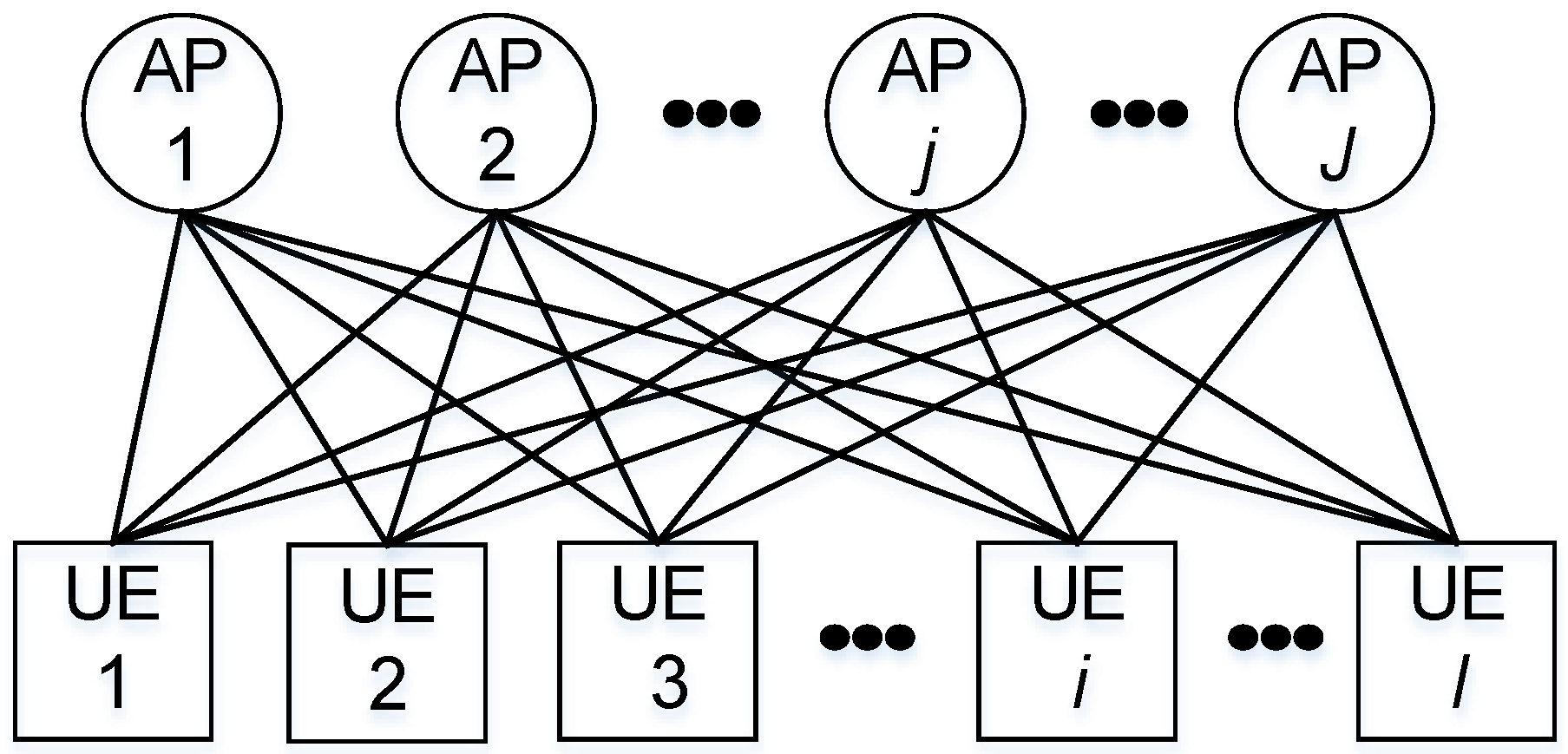

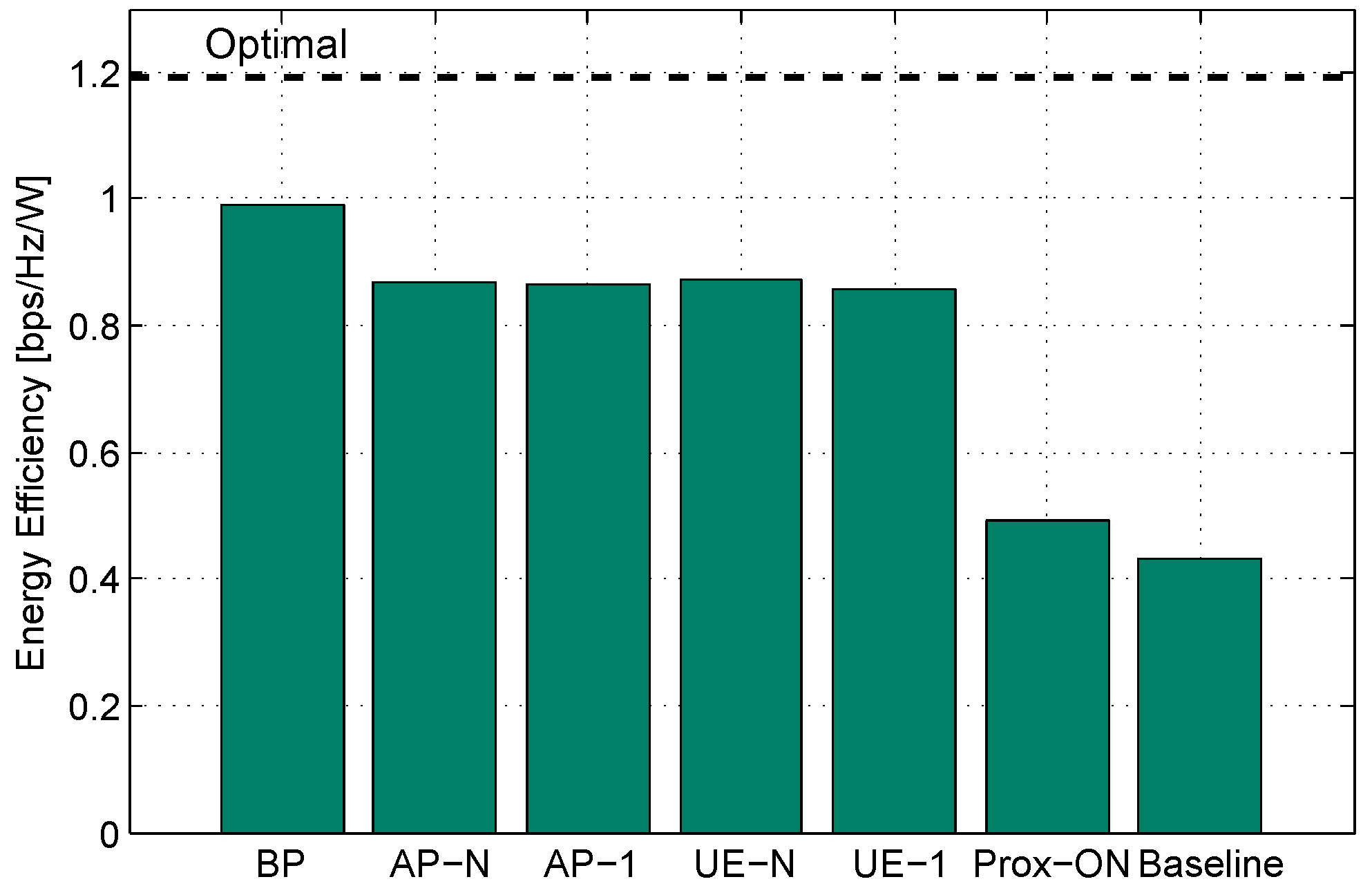
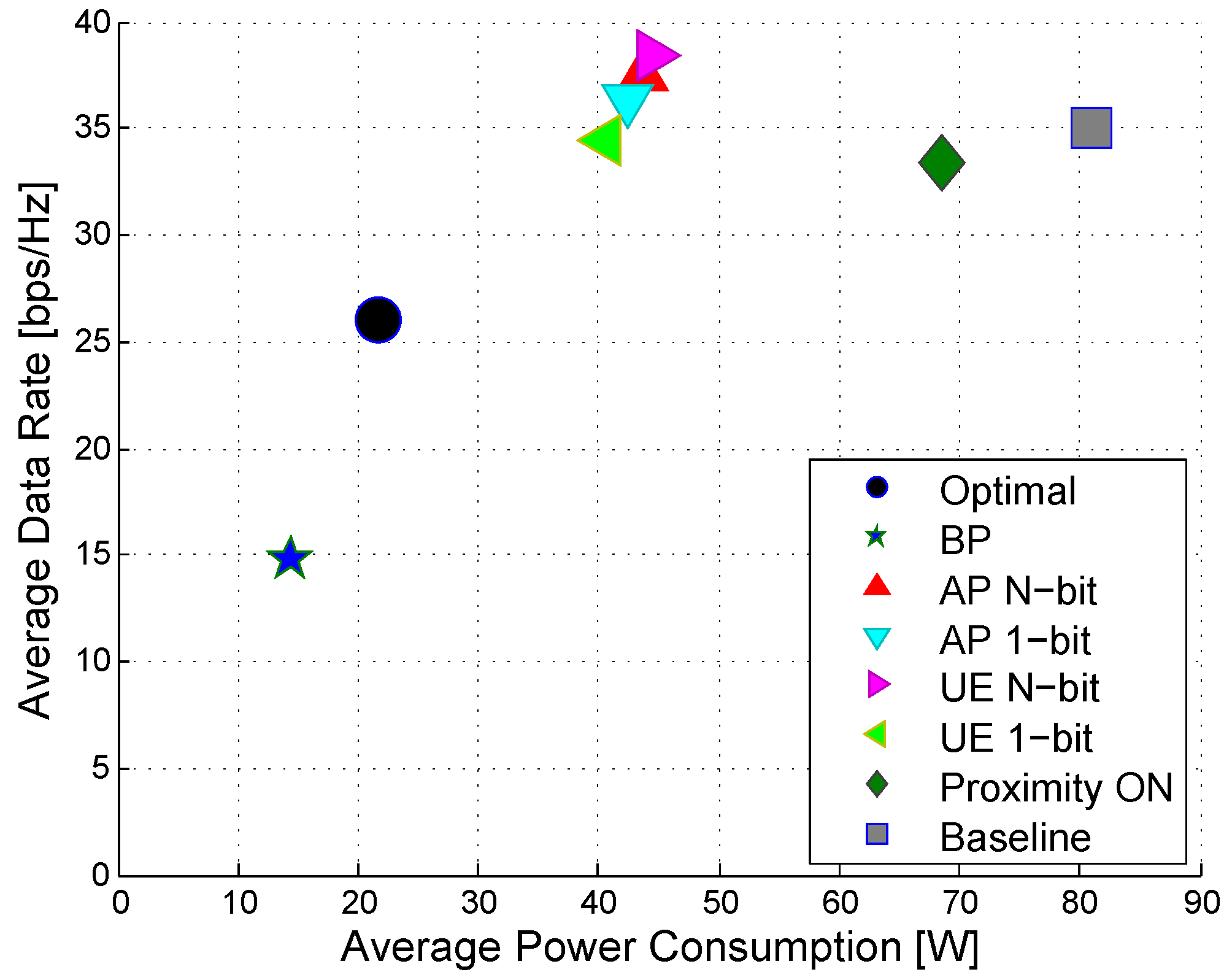

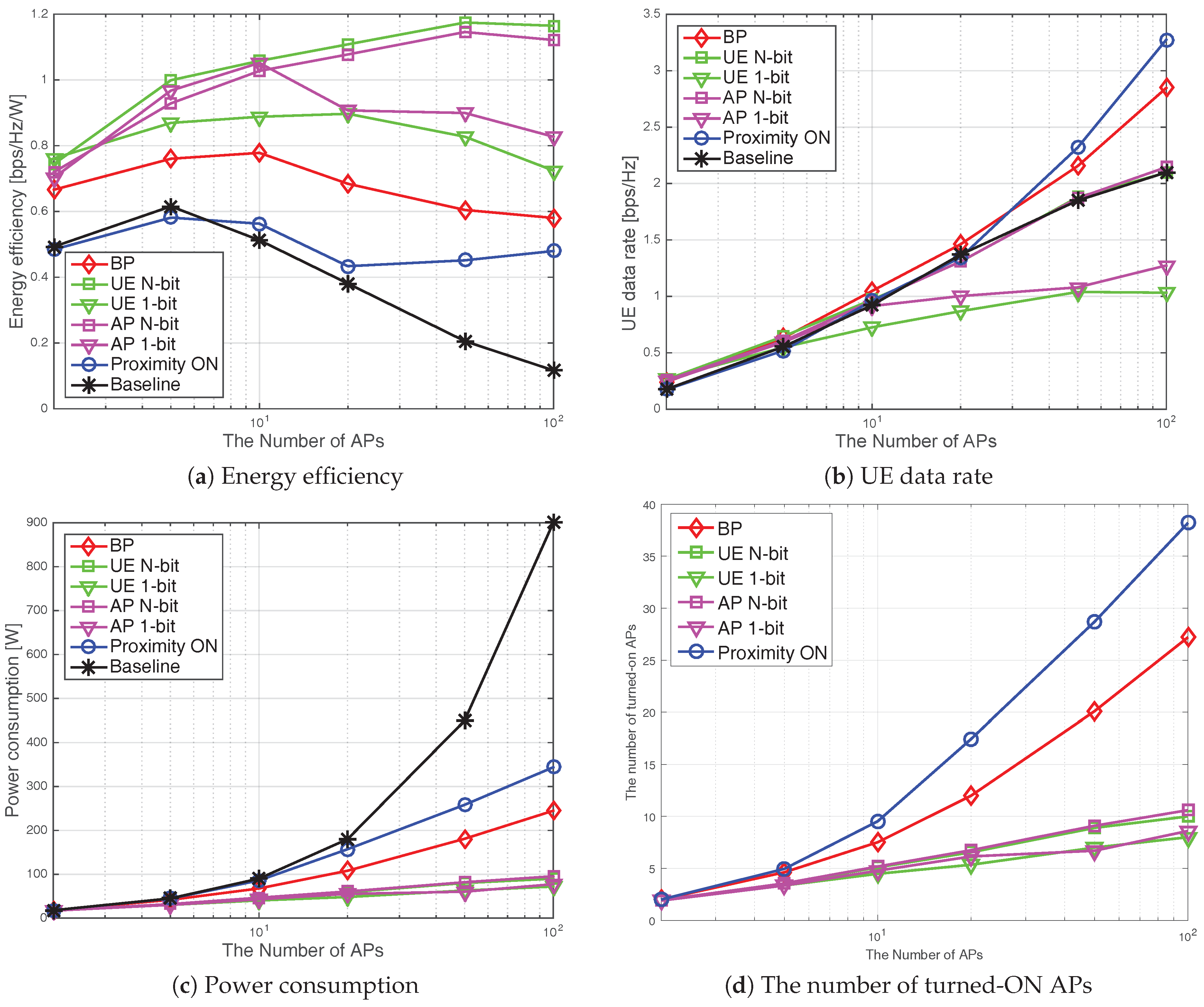

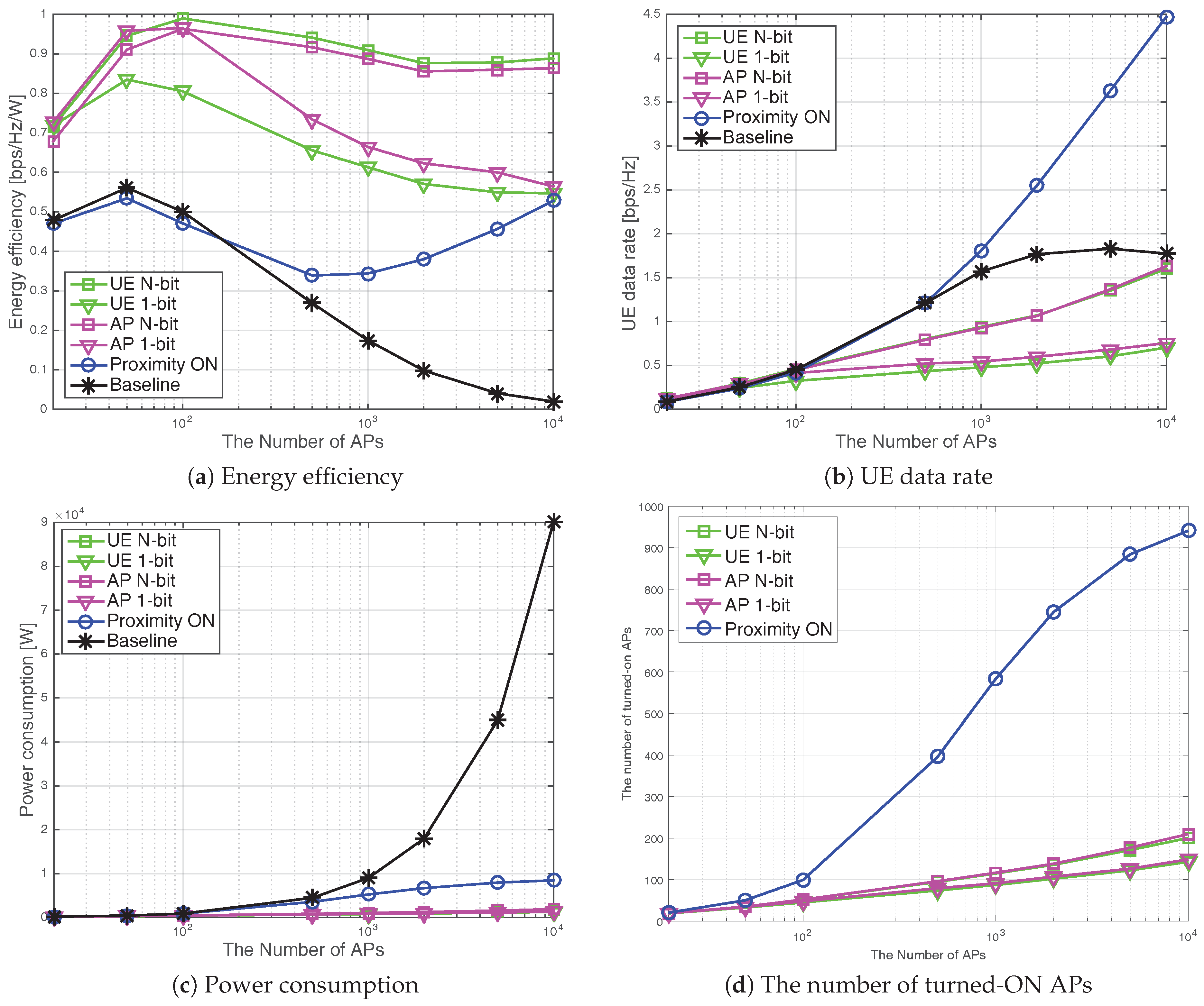
| 1-bit Feedback () | N-bit Feedback () | Association Matrix (S) |
|---|---|---|
| BP | AP-N | AP-1 | UE-N | UE-1 | Prox-ON |
|---|---|---|---|---|---|
| 129% | 101% | 100% | 102% | 98% | 14% |
© 2016 by the authors; licensee MDPI, Basel, Switzerland. This article is an open access article distributed under the terms and conditions of the Creative Commons Attribution (CC-BY) license (http://creativecommons.org/licenses/by/4.0/).
Share and Cite
Lee, G.; Kim, H. Green Small Cell Operation of Ultra-Dense Networks Using Device Assistance. Energies 2016, 9, 1065. https://doi.org/10.3390/en9121065
Lee G, Kim H. Green Small Cell Operation of Ultra-Dense Networks Using Device Assistance. Energies. 2016; 9(12):1065. https://doi.org/10.3390/en9121065
Chicago/Turabian StyleLee, Gilsoo, and Hongseok Kim. 2016. "Green Small Cell Operation of Ultra-Dense Networks Using Device Assistance" Energies 9, no. 12: 1065. https://doi.org/10.3390/en9121065
APA StyleLee, G., & Kim, H. (2016). Green Small Cell Operation of Ultra-Dense Networks Using Device Assistance. Energies, 9(12), 1065. https://doi.org/10.3390/en9121065







